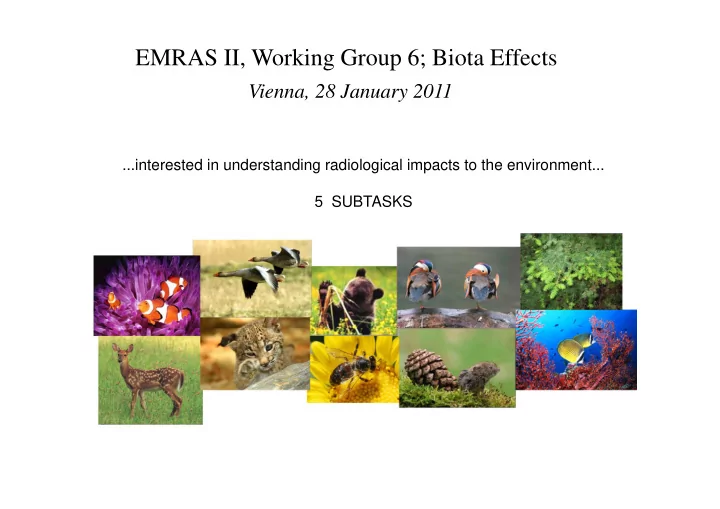

EMRAS II, Working Group 6; Biota Effects Vienna, 28 January 2011 ...interested in understanding radiological impacts to the environment... 5 SUBTASKS
TASK 1: FREDERICA Update Almudena REAL, CIEMAT To update FREDERICA we went through 3 steps: Literature survey Add new data to FREDERICA database QA/QC and score new entries Belgium (SCK-CEN): Nele Horeman; Hildegarde Vandenhove Germany (BfS): Christine Willdrot Japan (NIRS): Satoshi Yoshida, Drs Fuma and Maruyama Russian Federation (Ecomod; RIARAE): Tatiana Sazykina, Stanislav Geraskin Spain ( CIEMAT): Almudena Real Sweden (Vattenfall & SU): Synnove Sundell-Bergman, Karolina Stark United Kingdom (EA): Laura Newsome; David Copplestone
EMRAS-II (WG6): FREDERICA Update Around 1,500 references EMRAS-II efforts: 218 references 66 Russian literature (S. Geras’kin) 71 “ potentially ” useful for dose-response analysis (special thanks to D. Copplestone)
EMRAS-II (WG6): FREDERICA Update International Conference on Radioecology & Environmental Radioactivity. June 2011 Hamilton, Canada FREDERICA Effects Database Update within the EMRAS-II Programme: Contributing to evaluate the environmental impact of Ionizing Radiation. Real A., Horemans N, Newsome L., Oudalova A., Stark k., Willrodt C., Yoshida S., Hinton T.
TASK 2: Develop dose-response relationships and species sensitivity curves Jacqueline Garnier-Laplace, IRSN Table 6. Proposed organism group and generic ecosystems HDR 5 values (µGy h -1 ) estimated using SSD. r 2 Number Lowest Most sensitive wildlife SSD_HDR 5 * Protect SSD_HDR5** (µGy/h) of species EDR 10 group ( species ) (µGy/h) plants 9 514 Plant 192 (79-721) 0.924 n/a ( Solanum tuberosum ) invertebrates ates 10 35.8 Annelid 43.0 (5.53-744) 0.960 505 (55-4447) ( Ophryotrocha diadema ) vertebrates es 11 2.87 Mammal 1.4 (0.25-13) 0.951 2.1 (0.3-62) ( Capra hircus ) Generic cosystem 30 2.87 Mammal 9.55 (2.00 - 47.2) 0.976 17 (2-211) ecosystems ( Capra hircus ) *HDR 5 estimated using SSD : best estimate and associated 95 % confidence limits (in parenthesis) ***see Garnier-Laplace et al., 2010 for details
Table 7. Proposed organism group and generic ecosystems HD 5 values (mGy) estimated using SSD. r 2 Group Number Lowest Most sensitive wildlife SSD_HD 5 * of species ED 10 group ( species ) (mGy) Plants 9 970 Plant 630 (193-4009) 0.946 ( Vitis vinifera ) Invertebrates 10 53.2 Annelid 50.1 (6.74-414) 0.985 ( Ophryotrocha diadema ) Vertebrates 11 2.45 Mammal 2.56 (0.32-52.3) 0.956 ( Mus musculus ) Generic ecosystem 30 2.45 Mammal 18.4 (0.30-117) 0.973 ( Mus musculus ) *HD 5 estimated using SSD : best estimate and associated 95 % confidence limits (in parenthesis) Draft paper in Feb 11 chronic Draft paper in Sep 11 acute
Task 3: Canadian Benthic Data Set Steve Mihok, WG-4 and WG-6 Uranium mining regions with co-located benthos sampling & organic depositional sediments 132 Ontario & Saskatchewan sites 190 genera and/or species 12 contaminants: As, Cr, Cu, Mo, Ni, Pb, Se, U, V, Pb-210, Po-210, Ra-226
ANALYSIS OF THE CANADIAN BENTHIC DATABASE Claire Della - Vedova (magelis company) Principal Components Analysis vs Redundancy Analysis PCA and vectors fitting RDA
TASK 4: Multiple Stressors Task Group Hildegarde Vandenhove; SCK-CEN Literature Survey: Multi-stressor data with radiation being one of the stressors • Terrestrial plants 1) Draft paper: ‘ Review on the state of – Before QC analysis: 6 – After QC analysis: 5 multiple stressor research in • Aquatic plants – Before QC analysis: 1 radioecology ’ (publish by year-end). – After QC analysis: 1 • Terrestrial animals – Before QC analysis: 22 2) Review of approaches in ecotoxicology for effects – After QC analysis: 10 • Aquatic animals assessment in multiple stressor scenarios and Before QC analysis: 4 – their usefulness for environmental radiation – After QC analysis: 4 Freshwater microcosm • protection. This will include a short overview of – Before QC analysis: 1 – After QC analysis: 0 experimental set ups for studying multiple stressor • Marine estuarine – Before QC analysis: 19 effects. – After QC analysis: 13
TASK 5: Population Models and Alternative Methods Tatiana Sazykina, TYPHOON, Russia Benchmark scenario ”Population response to chronic irradiation” populations of • mice; • hare/rabbit; • wolf/wild dog; • deer. subjected to chronic low-LET radiation exposures with dose rates 10, 20, 30, 50 mGy/day:
Before irradiation, each population was in a stable state, consisted of 1000 animals, which corresponded to the carrying capacity of the ecosystem. The duration of exposure was 5 years; followed by an end of irradiation to examine recovery. Jordi Vives, Luigi Monte, Isao Kawaguchi, Tatiana Sazykina, Alexander Kryshev
10 mGy/day, 5 years 100 Population size, % of the control 80 60 40 20 0 Mice Rabbit Deer Wolf/dog
120 20 mGy/day, 5 years 100 Population size, % of the control 80 60 40 20 0 Mice Rabbit Deer Wolf/dog
…at 20 mGy/day all models predicted wolf and deer populations die out… larger animals = greater longevity = slower reproduction rate = populations with greater sensitivity to radiation. During 2011 a) Address the problematic issue of extrapolation from acute to chronic levels b) Establish a generic model, simple enough to be used across species c) Use this model to help direct future research on radiation effects to biota d) Discuss the potential usefulness of population modelling tools for regulators.
Recommend
More recommend